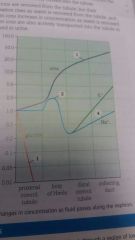![]()
![]()
![]()
Use LEFT and RIGHT arrow keys to navigate between flashcards;
Use UP and DOWN arrow keys to flip the card;
H to show hint;
A reads text to speech;
38 Cards in this Set
- Front
- Back
- 3rd side (hint)
|
Conditions needed to be maintained in cells |
A suitable Temperature A suitable pH An aqeous enviroment that keeps substrates in solition Freedom from toxins and access inhibitors |
4 |
|
|
What type of adaptations respond to stimulus (enviromental change) |
Phycological and behavioural |
|
|
|
Why is too much carbon dioxide in the blood bad |
It lowers the pH of the blood |
|
|
|
How does the body's internal enviroment change when their is too much carbon dioixde |
The reduced pH in the blood stimulates greater breathing to get rid of the carbon dioxide |
|
|
|
Why do you need changing internal enviroments |
To expel unhelpful waste products |
|
|
|
How does waste in tissue fluid stop not waste from being produced |
It builds up in the tissue fluid and on to the cells reducing their activities |
|
|
|
What is the main way waste products are realeased |
Excretion |
|
|
|
Good communication systems will |
Cover the whole body Enable cells to communicate with each other Enable specific communication Enable rapid communication Enable both short term and long term responses |
|
|
|
The 2 types of communication system |
Neuronal system and Hormonal system |
|
|
|
Key points of the neuronal system |
Interconnected network of neurons Signal through synaps junction The signal is very quick Rapid respose |
|
|
|
Key points of hormonal system |
Blood transport it's signals Hormones are transported all round the body but only target cells get signaled Enabled longer term responses |
|
|
|
Homeostasis controls |
Body temperature Body glucose concentration Blood salt concentration Water potential in blood Blood pressure Carbon dioxide concentration |
6 |
|
|
Standered response pathway for homeostasis |
Stimulus - receptor - communication pathway (cell signaling) - effector (the cell/organ/tissue that brings about the response) - response |
|
|
|
Negative Feedback |
A mechanism that reverse change bringing the system back to the optimum |
|
|
|
Where is change in temperature detected |
The thermo-regulatory centre in the hypothalamus |
|
|
|
Positive feedback |
The mechanism to increase change taking it away from the optimum |
|
|
|
Examples of positive feedback |
During pregnancy cervix dilation which stimulates the pituitary gland to release oxytocin which streches the cervix more |
|
|
|
Ectotherm |
An organism that relies I external scources of heat to maintain body temperature |
|
|
|
Endothern |
An organism that uses heat from metabolic factions to maintain body temperature |
|
|
|
If an ectotherm is to cool it will |
Move to a sunny area Lie on a warm surface Expose a large surface area to the sun |
|
|
|
If an ectotherm is to warm it will
|
Move out the sun Move underground Reduce the body surface exposed to the sun |
|
|
|
Advantages of ectothermy
|
Less of their food is used in respiration More energy is used for growth They need to find less food They can survive for long periods without food |
|
|
|
Disadvantages of ectothermy
|
Less active when cold
|
|
|
|
What does the skin do if the body is too hot
|
Sweat glands secrete sweat Hairs and feather lie flat to allow air flow Vasodilation of arterioles Blood is directed to the skin surface |
|
|
|
What does the skin do if the body is too cold
|
Less sweat secreted Hairs and feathers stand up to trap air which insulates the body Vasoconstriction of arterioles Blood is away from the skin surface |
|
|
|
What does the gaseous exchange system do if the body is too cold
|
Less panting, less heat lost |
|
|
|
What does the gaseous exchange system do if the body is too hot
|
Increased evaporation of water from lungs and airways using heat from the blood
|
|
|
|
What does the liver do if the body is too hot
|
Less respiration so less hear released
|
|
|
|
What does the liver do if the body is too cold |
Increased respiration that means more energy from food is converted to heat
|
|
|
|
What do the skeletal muscles do if the body is too hot
|
Fewer contractions so less heat is released
|
|
|
|
What do the skeletal muscles do if the body is too cold
|
Spontaneous muscle contractions (shivering) release heat
|
|
|
|
What do the blood vessels do if the body is too hot
|
Dilate to direct the blood to the extremities
|
|
|
|
What do the blood vessels do if the body is too cold
|
Constrict to direct the blood away from the extremities (This is frostbite)
|
|
|
|
Advantages of endothermy
|
Maintain a fairly constant body temperature what ever the external temperature Remain active when temperatures are low Inhabit areas of cold climate |
|
|
|
Disadvantages of endothermy
|
A significant amount of energy is used to maintain temperature Need more food Less energy is used for growth May overheat in warm weather |
|
|
|
What is the arrangment of the loop henle called |
The hairpin counter current multiplier system |
|
|
|
Draw the hairpin counter current multiplier system |

|
|
|
|
Draw the concentration changes in the title fluid |

|
|

